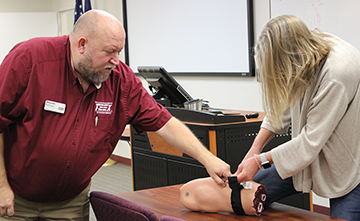Save A Life: TEEX offers class in the basics of bleeding control
COLLEGE STATION – Do you know how to control bleeding if someone has a severe cut? You could save a life if you can control the bleeding, and a free two-hour class can teach you how.
The new course, “Bleeding Control Basics,” teaches proper tourniquet use and pressure techniques to control bleeding until EMS arrives. The Texas A&M Engineering Extension Service (TEEX) is offering the course at no cost to residents of the Brazos Valley. Six classes are scheduled in January at the RELLIS Campus in Bryan.

Attendees learn about the principles of trauma care and get hands-on practice in compression, wound packing and use of a tourniquet. The course is aimed at people of all ages with a non-medical background.
“Victims can die from uncontrolled bleeding within five to 10 minutes,” said TEEX Instructor and retired Paramedic Steven Robinson, who teaches the class. “That’s why it is important for people to learn proper bleeding control techniques, much like they learn to perform CPR. With training, anyone on the scene of an accident where an injury causes life-threatening bleeding can act as an immediate responder and control the bleeding until help arrives.”
The nationwide push to get more people trained in bleeding control techniques stems from the shootings at Sandy Hook Elementary School in Newtown, CT, in 2012. Afterward, trauma surgeons from the American College of Surgeons and other experts met to discuss how to improve the rate of survival for people with severe bleeding. Their recommendation led to the goal of improving victim survival after acts of mass violence by empowering trained bystanders to take life-saving action to control severe bleeding.
In Texas, the passage of House Bill 496 now requires school districts to provide bleeding control stations and to offer hands-on training to school personnel and to students in grades 7-12 on their use. Officials say bleeding control kits help bystanders act quickly and effectively to save lives in typical emergency situations, such as vehicle accidents, sports injuries, and classroom or playground accidents.
“Bystanders with the right tools and training can save lives if they act in those critical first minutes before help arrives,” says Tony Tasillo, Manager of TEEX Educational Initiatives. “It’s a skill you hope you never have to use, but you never know if you might face unexpected violence or injuries that can occur in our daily lives. Severe cuts can occur in your own kitchen. And these techniques work on an injured pet as well.”
